The calendar showed January 30, 1969, when the four Beatles, along with Billy Preston, climbed onto the roof of the Apple Corps building at 3 Savile Row in London's Mayfair and played live for the last time, just months before their final dissolution. Magazine, 53 years later, remembers the 42 minutes that the legendary appearance of the "beetles" lasted.
In December 1968 the Beatles were going through a difficult period, since the appearance of Yoko Ono on the one hand and the "liberating" effect left on them by the trip to India - at the beginning of that year - on the other, caused the first serious rifts in their relationships. The problems were already evident from the recordings of the "White Album" (May - October 1968), which John Lennon had characterized as the beginning of the end of the band.
There, Ringo Starr had not played drums on "Back in the USSR" and "Dear Prudence", leaving McCartney in the role of drummer (!), while Lennon had lost interest in writing songs with Paul, saying that "Ob-La-Di Ob-La-Da" was "a piece of music for grandmothers". Having the "luxury" of recording on an eight-channel console, they could each record alone, without the presence of the others, making the album seem like a collection of solo recordings, rather than a collaborative band effort.
THE BIRTH OF THE "GET BACK" PROJECT
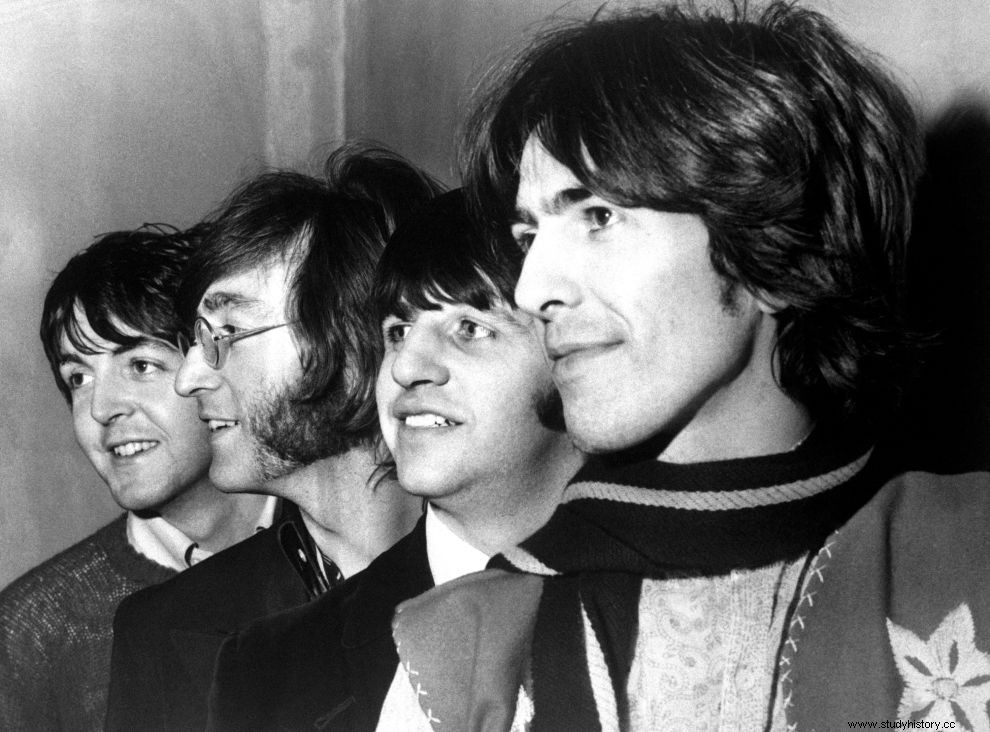
After the huge success of the record, McCartney suggested that the rest gather material for a new album, rehearse it and then perform it live in front of an audience and release it on vinyl and as a television documentary. Indeed, in early January 1969, the Beatles began working on the project called "Get back" at Twickenham Studios in London, while director Michael Lindsay Hogg collected several hours of material from the recordings.
But on January 10, George Harrison walked out of rehearsals, irritated with McCartney and Lennon, and when he returned five days later, he threatened to quit the group altogether unless two specific conditions were met. The first was to stop any talk of a live show/concert and the second was to leave Twickenham and record the songs for the new album at Apple Studio in the basement of the Apple Corps building, the band's new "headquarters".
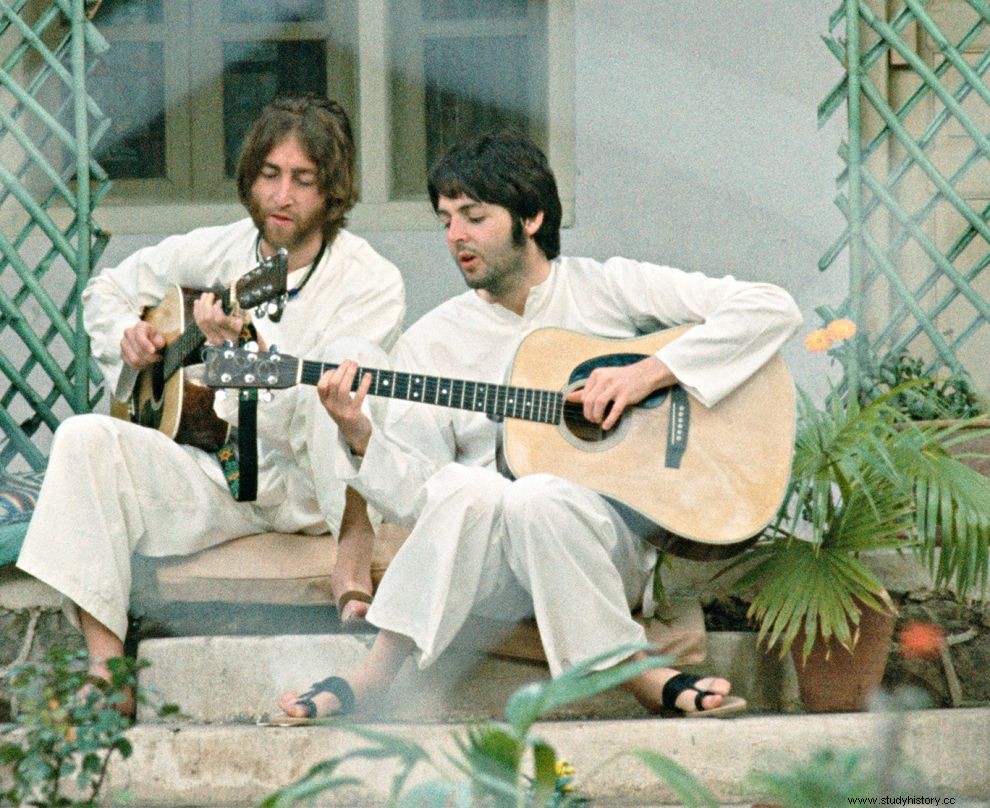
The remaining three agreed, and together they decided that the material that Lindsey Hogg had gathered for the television production, would eventually be used to make a film in the future. On January 22, Harrison made another move, bringing keyboardist Billy Preston into the studio with him as an additional member for the final nine days of recording, hoping that the presence of a talented musician would encourage the band to focus even more on their goal.
Despite Harrison's stipulation, both McCartney and Lindsey Hogg continued to hope that the Beatles, when they finished recording the album, would perform live in front of an audience. Talks about a live show started again at some point, with many different ideas as to where this concert could possibly take place. Among others, the London Palladium theater in Soho, the Roundhouse concert hall, also in London, the Sahara desert (!), the Giza pyramids, the Queen Elizabeth 2 cruise ship, and even a psychiatric clinic were proposed!
THE IDEA OF LIVE ON THE ROOF

Another proposal involved an old - 2,000-year-old - Roman amphitheater in Tunisia, where the Beatles would start playing just at sunrise, and Apple even sent people there to examine the space and see exactly what would be needed for to be able to set up the live! Ultimately none of these ideas went ahead and as the initial enthusiasm for a live show waned, the quartet decided to do something much simpler and closer to their "headquarters".
According to Preston, the idea to play on the roof of the Apple building belonged to Lennon. Lindsay Hogg claims it was his own inspiration, while others attribute it to Ringo Starr. In his autobiography, sound engineer Glenn Jones writes that it was actually Ringo who, during a break from recording on January 26, told the others that the view of the West End from the roof was amazing. and took him and Lindsey Hogg to show her to them.
COPYING THE JEFFERSON AIRPLANE?

Jones and Lindsay Hogg then pitched the idea to McCartney, who was thrilled. Let us say here that the Beatles were not the first to play on a roof, in fact it is not at all unlikely that they wanted to copy the Jefferson Airplane, who a few weeks earlier, on December 7, 1968, went up to the roof of the Schuyler Hotel in New York and surprised the passers-by by shouting from their microphones:"Hello New York! Wake up, you fuckers! Free music! Nice songs! Free love!"
The legendary psychedelic band from San Francisco, of course, didn't have a permit for the happening, so they only managed to play one song, "The house at Pooneil Corners", with the NYPD arriving and threatening them with arrest for disorderly conduct. of common peace. The band members left peacefully, but a friend who was present, actor Rip Thorne, assaulted a police officer, causing him to be taken away in a police car while wearing handcuffs. The whole scene was captured with his camera by Jean-Luc Godard for the documentary "One A.M."
ENDING IN THE ROOFTOP SOLUTION

But back to the Beatles, where things continued to be confusing. Ringo, as the days went by, appeared determined not to take part in the live, while Harrison also seemed completely reluctant. In Lindsey Hogg's audio tapes from January 29, McCartney can be heard trying to convince Lennon that a live show was necessary to keep the band in touch with their audience and that all the four of them needed was to get over their stage fright.
The truth is that the Beatles had stopped their live concerts almost two and a half years ago, determined to devote themselves exclusively to recordings. The last time they had played in front of people was on August 29, 1966, at Candlestick Park in San Francisco. However, on the same night of January 29, in a joint conversation that the "beetles" had, Harrison spoke for the first time with enthusiasm about the live, even saying that it would be fun to play with "spectators" in the chimneys. But he made it clear that under no circumstances would he accept any of his own songs to be included in the list.
THE BEATLES INSTRUMENTS
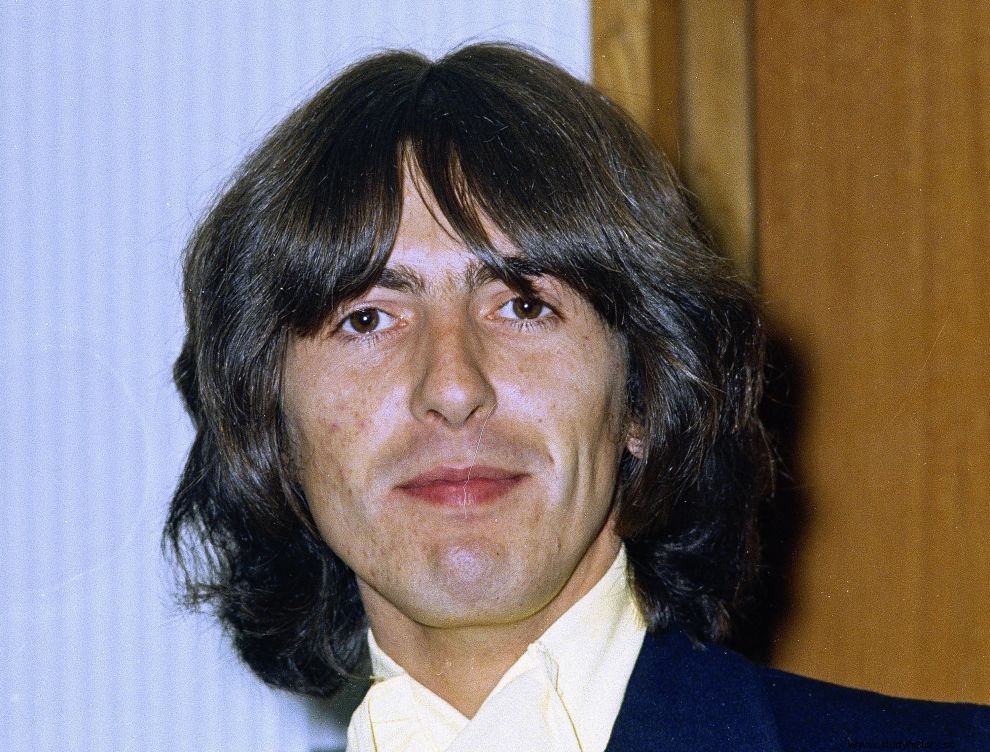
Mal Evans, the band's road manager, organized the space on the roof of the Apple Corps building, setting up a stage and preparing the musicians' instruments:Lennon's Epiphone Casino (Gibson) guitar, McCartney's classic Höfner Violin bass, a Ludwig drum kit for Ringo, an electric piano for Billy Preston and a brand new Fender Telecaster guitar for Harrison. This Telecaster, crafted by master designers Roger Rosmeisl and Phil Kubitsky, was a gift from Fender to Harrison.
Fender was launching a new line of electric guitars made entirely of rosewood at the time, and sent the prototype to Harrison, thinking it would be the ultimate advertisement. The guitar had traveled by air in its own place (!) and had been delivered to Beatles headquarters. The makers had no idea for over a year what had become of the Telecaster, until they bought tickets to see the movie "Let it be" and saw it on the screen. "I was so excited, I almost jumped out of my seat," Kubicki later recalled.
BANK ROBBER OR TRANSVESTI!

The strong wind blowing on January 30 in London caused problems for the sensitive microphones that would record the drums and amplifiers from the guitars. Some way of minimizing wind noise had to be found and the solution came from assistant sound engineer Alan Parsons (later founder of the Alan Parsons Project). As he himself confessed some years later in "Guitar Player":"I walked into a Marks &Spencer store and said, I want three pairs of tights, I don't care about the size. They would have thought I was either a bank robber or a transvestite".
They covered the microphones with the tights, thus protecting them from the strong gusts of wind. The impending fog forced them to abandon the idea of a helicopter flying over the building to film the live, and they limited themselves to ten cameras set up in the following places:six were placed on the roof, one - without permission - on the opposite building, another - hidden - at Apple Corps reception in case of a police raid and two on the street to record people's reactions and to interview passers-by on the spot.
"OH FUCK IT, LET'S DO IT"
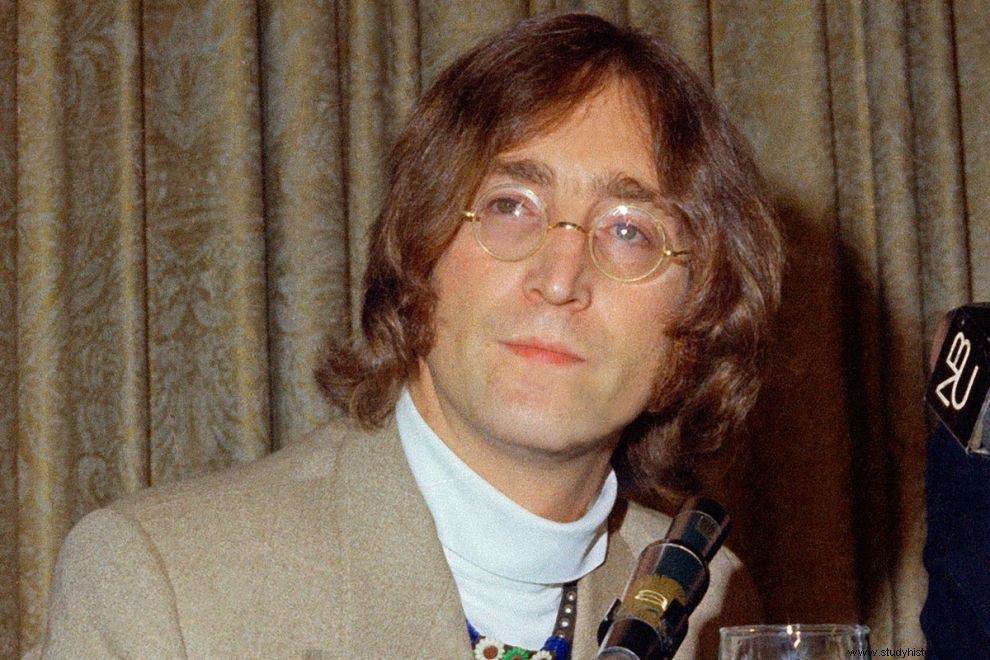
Everything was now ready on the roof, but according to Lindsey Hogg, even minutes before the scheduled start of the live show, the Beatles were still having doubts about whether or not they should play:"Harrison didn't want to do it, while Ringo grumbled that he didn't see the point in it all. The four of them had gathered outside the terrace door and after each had given their opinions there was silence. At one point Lennon said 'Oh fuck it, let's do it' and that was it".
The four beetles, along with Billy Preston, came out onto the roof at about 12:30 in the afternoon. The temperature was 7 degrees Celsius, while there was always the threat of rain. Lennon borrowed from Yoko Ono her fur coat and Ringo from his wife, Maureen, her red raincoat. However, throughout the live performance Lennon muttered that his hands were too cold to play the chords on the guitar, while Apple Corps executive Ken Mansfield kept lit cigarettes in his hands to warm his fingers. Harrison!

There was one more problem, Lennon's proverbial inability to memorize song lyrics. So, in order not to mess with the flow of the filming, the rest of the Beatles asked Apple employee Kevin Harrington to kneel out of view of the cameras and hold a piece of paper with the lyrics to "Dig a Pony". However, Lennon managed to forget the lyrics of "Don't let me down" and sing an unintelligible "And only reese we got the blootchy-koo"!
When the Beatles and Preston started playing, there was immediate commotion and confusion in the surrounding buildings, where most of the workers were on their lunch break at the time. With the news that the "beetles" were playing live, spreading quickly, crowds of people began to gather in the surrounding streets, but also on the roofs of neighboring buildings, listening and watching the legendary band in ecstasy.
CHAOS IN THE STREETS AND PROTESTS TO THE POLICE

But a number of shopkeepers in the area contacted the Metropolitan Police, complaining about the noise and traffic jams caused by crazed Beatles fans stopping their cars in the middle of the road and getting out of them to listen to the concert. The central police station of the West End was located at number 27 Savile Raw, only a few meters from the Apple Corps building.
It was obvious that the police had immediately realized what was going on, not only from the sound of the "Beetles" instruments, but also from the constant honking of horns outside on the road, from outraged drivers who did not share the enthusiasm of the band's fans. The truth is, if the police wanted to, they could have stopped the live before the first song was even finished, but they preferred to let the Beatles complete 42 minutes playing on the roof. They decided to intervene, only when shopkeepers "invaded" the department en masse, demanding the restoration of order.
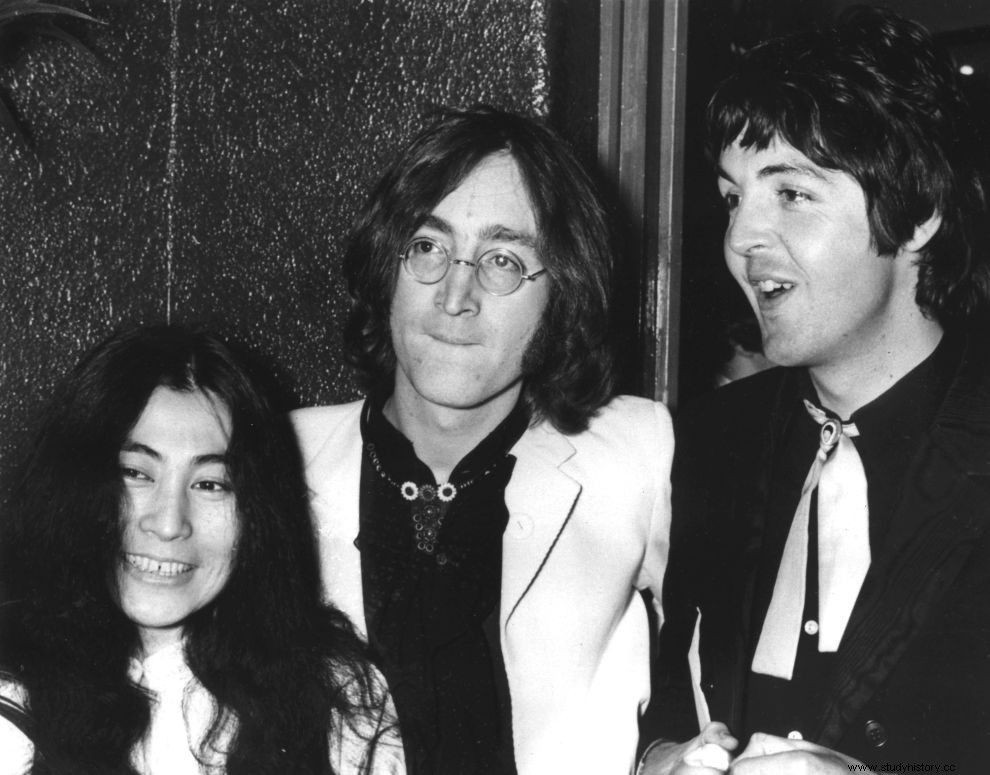
The phrase of Stanley Davis, a woolen cloth merchant who had his shop in the adjacent building of Apple Corps, who said to the police:"I want this bloody noise stopped. It's an absolute disgrace" has remained historical the fucking noise. It's an absolute disgrace). A completely opposite view was expressed by another neighbor of Savile Row, banker Alan Palverness, who, completely disappointed by the inglorious end of the concert, told reporters:"Some people just can't appreciate good music" the good music).
Nevertheless, the police wanted to give the group time, so that they could get rid of - mainly - illegal substances (see drugs) that they might have on them. Before the police "doo", someone from the department called Apple Corps, saying "you have ten minutes". So no one in the building was surprised when law enforcement arrived. An Apple employee's signature line says it all:"When the police entered the building, there was a veritable chorus of water cannons being fired at the same time"!!!
LIVE UNDER THE LOOK OF THE POLICE

Initially, Apple employees at the front desk refused to allow the police to climb onto the roof, but were forced to change their minds when threatened with arrest. On the other hand, the Beatles considered the intervention of the police certain, mainly because the department was only a few meters away. Finally, the constables appeared on the roof, just as the band began to play "Don't let me down" for the second time.
Immediately afterwards, in the final performance of "Get back", McCartney improvised by changing the lyrics of the song:"You've been out too long Loretta, playing on the roofs again, and that's no good, 'cause you know your mummy doesn't t like that. Oh, she gets angry. She's gonna have you arrested! Get back!" However, with "Get back" halfway through, Mal Evans was forced - under the strict eyes of the police - to turn off Harrison's and Lennon's amplifiers. Immediately Harrison opened his again and then Evans opened Lennon's as well.
THE ROOFTOP CONCERT SONGS
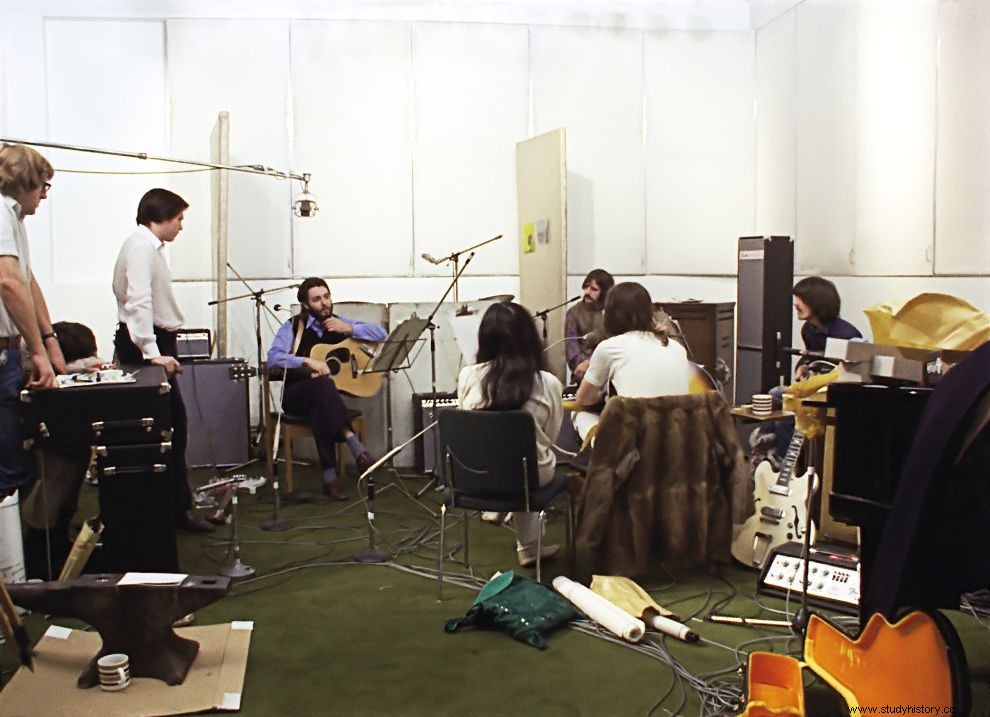
On the roof were three constables, Ray Doug, Ray Sailer and David Kendrick. Once the final "Get back" was finished, they headed out to arrest Evans for turning on Lennon's amplifier, but after McCartney intervened, they were persuaded to release him. But let's remember at this point, which songs the Beatles and Preston played in those 42 minutes. Let's say first, that the recording was done from the basement studio of the building, with Jones and Parsons in charge.
The beetles performed three performances of "Get back", two performances of "Don't let me down", "I've got a feeling" and "Dig a Pony" and one performance of "One after 909" . Apart from these, they also played some other songs, but unfinished:"I want you (She's so heavy)", "Danny Boy", "A pretty girl is like a melody", as well as an improvisation of "God save the Queen", which was not recorded because at the time Parsons was changing reels in the basement. In fact, five songs were heard in full.
A WORD ABOUT BILLY PRESTON

The big star, the MVP if you will, of the rooftop concert was none other than Billy Preston. A virtuoso keyboardist as well as composer and singer, Preston rose to fame in the 1960s for his collaborations as a session musician, with Little Richard, Sam Cooke, Ray Charles, the Everly Brothers, the Beatles, the Rolling Stones and many others. After the breakup of the "beetles" he continued to collaborate in the 70s with George Harrison, but also with Eric Clapton and the Stones.
Preston had known and been friends with the Beatles since 1962 and their European tour with Little Richard. When Harrison left the band on January 10, 1969, to calm down, he went to see a Ray Charles concert, where Preston was playing harmonium. It was there that George invited him to go into the studio and jam with the rest. Η παρουσία του ηρέμησε τις εντάσεις ανάμεσα στην υπόλοιπη τετράδα, ενώ ο ήχος των πλήκτρων του, πρόσφερε ένα ξεχωριστό χρώμα στις ηχογραφήσεις.

Ο Λένον μάλιστα, είχε σκεφτεί μήπως τον έπαιρναν ως μόνιμο μέλος στο συγκρότημα, ως τον πέμπτο Beatle, όμως είχε αντιδράσει σε κάτι τέτοιο ο ΜακΚάρτνεϊ, λέγοντας ότι "αρκετά προβλήματα έχουμε ως τετράδα"! Παρόλα αυτά, οι Beatles αναγνώρισαν τη συνεισφορά του Πρέστον, προσθέτοντας το όνομά του στο 45άρι που κυκλοφόρησε τον Απρίλιο του 1969 με το "Get back" και το "Don't let me down". Πάνω στο εξώφυλλο του single αναγραφόταν "The Beatles with Billy Preston", κάτι που δεν είχε ξαναγίνει ποτέ για οποιονδήποτε άλλο μουσικό σε οποιοδήποτε άλμπουμ ή 45άρι των "σκαθαριών".
Ο Πρέστον πήρε μέρος το ίδιο καλοκαίρι και στις ηχογραφήσεις του LP "Abbey Road", όπου έπαιξε Hammond σε δυο τραγούδια, το "I want you (She's so heavy)" και το "Something". Πριν κλείσουμε την απαραίτητη αυτή παρένθεση στον μεγάλο αυτό κιμπορντίστα, για όσους δεν τον γνωρίζετε, ακούστε το "Ain't no time to play", δική του σύνθεση, για να πάρετε μια ιδέα του ήχου του (ένα υπέροχο fusion από garage, r&b και soul), καθώς και την μοναδική του ερμηνεία στο "My sweet lord", στο "Concert for George" στις 29 Νοεμβρίου του 2002 στο Royal Albert Hall, στην πρώτη επέτειο από τον θάνατο του Τζορτζ Χάρισον.
"I HOPE WE PASSED THE AUDITION"!

Επιστρέφουμε στην ταράτσα του Apple Corps, όπου αφού τελείωσε και η τρίτη εκτέλεση του "Get back", ο ΜακΚάρτνεϊ είπε απευθυνόμενος στη σύζυγο του Ρίνγκο, Μορίν Στάρκεϊ, "Thanks, Mo!" για να την ευχαριστήσει, επειδή ήταν ίσως η μόνη που αντιμετώπισε το όλο χάπενινγκ με ενθουσιασμό. Στη συνέχεια ο Λένον έριξε οριστικά την αυλαία λέγοντας το ιστορικό πλέον "I'd like to say thank you on behalf of the group and ourselves and I hope we passed the audition!" (θα ήθελα να πω ευχαριστώ εκ μέρους της μπάντας και ελπίζω να περάσαμε την ακρόαση).
* Ηχητικό:Το "Rooftop Concert" των Beatles (30/1/1969)
Εννέα ολοκληρωμένα κομμάτια κυκλοφόρησαν σε ένα από τα γνωστότερα LP bootleg της μπάντας, ενώ συμπεριλήφθηκαν και στο φιλμ, το οποίο τελικά βγήκε όχι με την αρχική ονομασία "Get back", αλλά ως "Let it be". Η ταινία έκανε πρεμιέρα στο "Liverpool Gaumont" στις 20 Μαΐου του 1970 και οι Beatles κέρδισαν το Όσκαρ με το "Let it be" στην κατηγορία καλύτερης πρωτότυπης μουσικής, καθώς και ένα Grammy για την καλύτερη μουσική επένδυση. Κανένα από τα "σκαθάρια" δεν εμφανίστηκε στην 43η τελετή απονομής των Όσκαρ (15/4/1971). Λίγες μέρες αργότερα ο ΜακΚάρτνεϊ παρέλαβε το αγαλματάκι, αλλά πλέον είχε ήδη μεσολαβήσει ένας χρόνος από την οριστική διάλυση της μπάντας και το σημαντικότερο κεφάλαιο στην ιστορία της σύγχρονης μουσικής είχε κλείσει για πάντα...
* Βίντεο:The Beatles - Get back (The rooftop concert, 30/1/1969)
* Βίντεο:The Beatles - Don't let me down (The rooftop concert, 30/1/1969)
